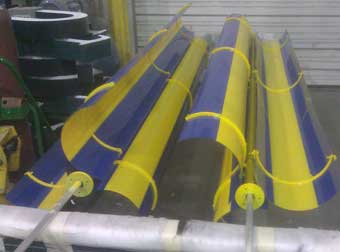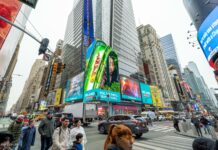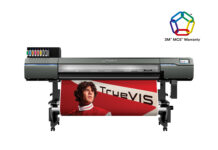The sign industry is full of innovation and new ideas, and the limits of what is considered signage are always being stretched.
Keith Tully, owner of Power Wall Systems, LLC in Fishers, Indiana, has stretched those boundaries just a little further with his combined pylon signs and wind turbines.
“The hardest aspect of what I do is to convince people that they can work with my products,” he says.
Tully, who worked for nine years in accounting sales for Federal Heath Sign Company, came up with the idea for his combination signs when he was looking for a wind turbine to power his electric mower.
“One client used two different colors of turbines to spell out their initials,” says Tully. “I thought, ‘Wow, it’s a wind turbine and a sign. If you could combine an illuminated sign and wind turbine, you would really have a great product.’”
Through further research, Tully found a vertical axis wind turbine, which spins in a vertical plane. While this type of turbine has advantages in low winds and crowded areas, it also has a disadvantage in that half of the turbine spins with the wind, and the other half spins against it.
“My idea was to then insert the wind turbine halfway into the sign cabinet so that the sign itself would shield the portion of the rotor that spins against the wind,” explains Tully. “I made small models and tested the concept. The shielding increased the speed of the rotors by as much 270 percent.
“At that point, I decided to apply for a patent and go into business.”
Tully’s previous career in the sign industry gave him a network to reach out to, which provided his first customer, Speedco in Dallas, Texas. Bridgestone/Firestone had purchased Speedco and was implementing a corporate-wide program to lower CO2 emissions. Speedco was very interested in the green aspects of Tully’s wind turbine sign.
Dallas’s sign code even included wind turbines. “The city was enthusiastic and allowed us to grandfather in the existing pylon steel without having to meet the newer and more expensive IBC standard,” says Tully.
(Note: According to Tully, even cities with restrictive sign codes are usually open to the idea of wind turbine signs because of their interest in green energy.)
With the wind turbine sign greenlit, Tully provided Speedco with a concept drawing and a video of what the sign would look like with the turbines spinning.
“I’ve never had anyone that looked at one and [not] like the way it looked,” says Tully. “The big concern is that it will draw your attention away from the main ID cabinet, but it frames the sign face rather than distracts from it.”
After approval, Tully reached out to another of his previous sign clients—Frank Green, owner of Awning Innovations in Fishers, Indiana—to handle the manufacturing.
In addition, Tully had mechanical and electrical engineers, as well as engineering professors and students from the local college, working on this unique project.

One of the hurdles the team ran into was UL approval. To ensure compliance, the sign was built as a stand-alone illuminated sign with the turbines housed in their own housings that bolted to the main ID cabinet.
(Note: UL approval covers the main illuminated cabinet, and since the wind turbines are non-illuminated and attached to the sides, they aren’t considered part of the main cabinet.)
Rather than buy a costly completd wind turbine, Tully made sure the rotor blades were made from formed polycarbonate and vinyl. By making the rotors in-house, the manufacturer was also able to perfectly match them to the faces of the pylon sign.
The other major hurdle was finding the proper balance between the size of the rotors, inverters, and generators. A bigger generator requires a larger diameter rotor, which creates more resistance and requires a stronger wind force to move.
The team took time to test the size of all three pieces. “We basically have good, better, and best system levels,” says Tully. “Our largest system would require sixty-inch-diameter rotors to drive two 3500-watt generators. This system would be reserved for the largest pylon signs at heights of eighty feet or more in unobstructed locations.
“Our smallest system, with only 500 watts per generator, will produce a small fraction of that power and may not produce enough to power just the sign.”
So just how exactly do the wind turbines work?
“The wind spins the rotors,” says Tully, “and the rotors spin generators connected below each rotor. The generator generates electricity in a wide range of voltages and amperages, depending on how fast or slow the generators spin.
“The ‘wild’ electricity is sent through the sign cabinet and down the pipe where it’s brought into a box on the base of the sign. There the electricity is first rectified to direct current, then the power is sent to an inverter that changes the electricity back to alternating current. A dedicated circuit is sent from the panel box to the inverter.”
From there, the grid tied inverter synchronizes the electricity with the grid’s “utility grade” AC electricity. The power is sent back to the panel box to be used as needed to offset the location’s overall electrical consumption.

That is an important distinction—because wind speeds are so unpredictable, the wind turbines aren’t meant to be the sole power supply for the sign; they’re only meant to generate supplemental energy. Some customers have even worked out a deal with the utility company to sell back the extra power.
The system also features built-in safeguards.
“In the case of a power outage, the inverter will read the drop in power in the line and will divert the power from the turbine to a ‘dumpload,’” explains Tully. “A dumpload is simply a heater coil that is used to burn off excess or unwanted power.
“In addition, a disconnect switch is located on the side of the box to allow the system to be disconnected for maintenance work on the turbines.”
AI Innovations also fabricated the double-sided cabinet the turbines attach to.
The cabinet framing system for attaching the faces couldn’t stick out too far, since the turbines had to be bolted to either side and manufacturers didn’t want the turbines to have to be unbolted to service the faces. The solution was to make the face retention system flush with the cabinet so the turbines didn’t have to be touched.
High-output fluorescents were used to illuminate the cabinet, since LEDs were cost-prohibitive in such a large cabinet.
The cabinet is concave, which also proved challenging when figuring out how to populate it so that light dispersed properly. Templates from lighting manufacturers were no help because they assume the cabinet is square. So the lighting was laid out by hand through trial and error.
Before transporting the sign to the install site, the team made sure everything fit together. “[The rotors] actually fit attached to the generator, which is attached to the base of the sign; it’s bolted to the steel inside the sign and then it fits into a bearing up above,” says Tully. “We made sure that it would spin freely.”
The formed faces of the rotor were then removed for transportation so they wouldn’t be spinning at high speeds as the sign was transported down the highway.
National Signs and Service of Fate, Texas handled the installation. Tulley did some work ahead of time to make the install as smooth as possible, like pre-installing the wind turbine equipment in boxes that would be mounted on the pylon steel.
“The wiring from the generators to the equipment boxes were also prewired into the sign cabinet,” he says. “The installer only needed to run the wiring down the pole and into the boxes.

“The wiring was then completed and the circuit was left open until approval from the power company had been received.”
Because of the integrated design, both the pylon sign and the turbines are eligible for a 30 percent immediate federal tax credit.
“This lowers the cost of the sign and turbines to less than the cost of a standard pylon sign of the same size,” says Tully. “The break-even point, when you add that extra 30 percent tax discount, is under $10,000.
“So if a sign is $10,000 or more, it’s either going to be cheaper or the same price to go with a wind turbine sign.”
By Ashley Bray
All photos: Power Wall Systems, LLC.











